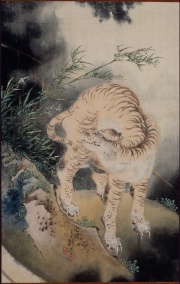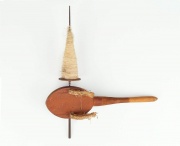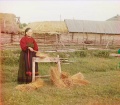Flax
Description
Any plant of the genus Linum, especially Linum usitatissimum that is native to Europe. Flax plants are grown for both their fibers and seeds. Flax fibers are believed to be the first vegetable fiber used by man (about 5000 CBE). They have been found in prehistoric cave dwellings in Switzerland. Ancient Egyptian pictographs detail the process for making flax into cloth and linen mummy cloths have been found. By the 17th century, linen manufacturing was an important industry in Western Europe. The soft, flexible fibers are produced by retting the stem of the plant, then washing and cleaning the fibers. Flax fibers of thinner and longer than cotton, but the fiber tube has thicker walls resulting in a stronger thread. Additionally, flax fibers are used to make shoe thread, bookbinding thread, fish line, twine, and paper. Waste flax fibers are used in banknotes, cigarette covers, and writing paper. The seeds from the flax plant are used to produce linseed oil. Linseed oil is used for cooking and as a paint medium.
Synonyms and Related Terms
Linum usitatissimum; Hør (Deut.); lino (Esp.); linum (Fr.); vlas (Ned.); linho (Port.); lin (Sven.);
Other Properties
Resistant to alkali, dilute acid, most organic solvents. Degrades in strong acids. Elongation = 1.8% (dry); 2.2% (wet); Moisture regain = 12%; Fiber length = 6-65 mm; diameter = 0.02 mm; Natural fiber color = yelloish to pale gray. Chlorine test stains linen fibers a bright red.
| Density | 1.5 |
|---|
Hazards and Safety
Degrades slowly in sunlight and temperatures above 120C. Resistant to mildew, insects and pests. Silverfish will eat starched flax.
Additional Information
G.Cook, Handbook of Textile Fibres:I. Natural Fibres, 5th edition, Merrow Publishing Co., Durham, England, 1984.
Additional Images
Authority
- The Dictionary of Paper, American Paper Institute, New York, Fourth Edition, 1980
- Hoechst Celanese Corporation, Dictionary of Fiber & Textile Technology (older version called Man-made Fiber and Textile Dictionary, 1965), Hoechst Celanese Corporation, Charlotte NC, 1990
- Matt Roberts, Don Etherington, Bookbinding and the Conservation of Books: a Dictionary of Descriptive Terminology, U.S. Government Printing Office, Washington DC, 1982
- Marjory L. Joseph, Introductory Textile Science, Holt, Rinehart and Winston, Fort Worth, TX, 1986
- Wikipedia, the free encyclopedia, at http://www.wikipedia.com Comment: http://en.wikipedia.org/wiki/Flax (Accessed Nov. 2, 2005)
- G.S.Brady, Materials Handbook, McGraw-Hill Book Co., New York, 1971
- Ralph Mayer, A Dictionary of Art Terms and Techniques, Harper and Row Publishers, New York, 1969 (also 1945 printing)
- Henry Hodges, Artifacts: An Introduction to Early Materials and Technology, Ronald P. Frye, Kingston, Canada, 1988
- A.Lucas, J.R.Harris, Ancient Egyptian Materials and Industries, Edward Arnold Publishers Ltd., London, 4th edition, 1962
- Book and Paper Group, Paper Conservation Catalog, AIC, 1984, 1989
- Richard S. Lewis, Hawley's Condensed Chemical Dictionary, Van Nostrand Reinhold, New York, 10th ed., 1993
- Van Nostrand's Scientific Encyclopedia, Douglas M. Considine (ed.), Van Nostrand Reinhold, New York, 1976
- Random House, Webster's Encyclopedic Unabridged Dictionary of the English Language, Grammercy Book, New York, 1997
- Art and Architecture Thesaurus Online, http://www.getty.edu/research/tools/vocabulary/aat/, J. Paul Getty Trust, Los Angeles, 2000










